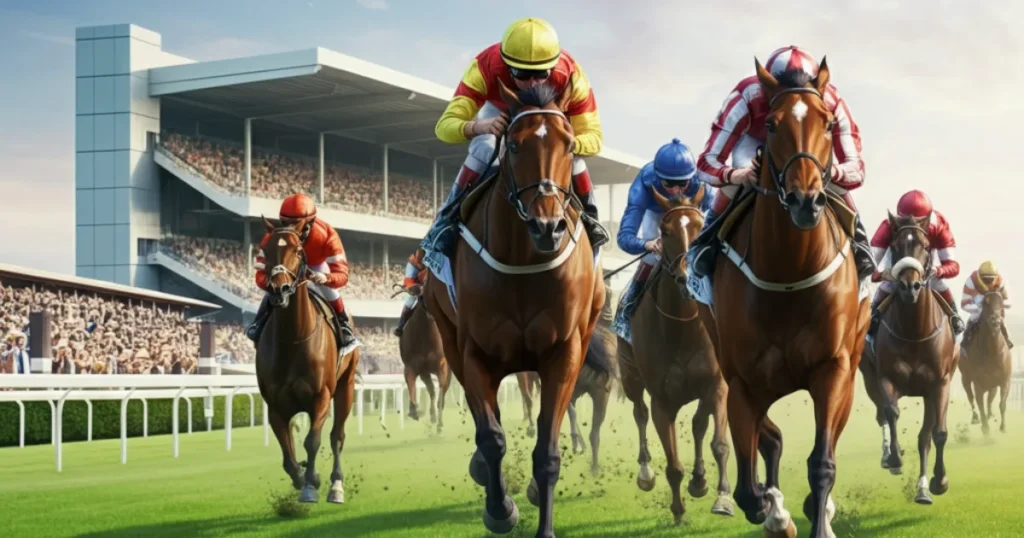Horse racing has always been a sport that combines tradition, strategy, and innovation. Among the many elements that contribute to the spectacle, one of the most underrated yet essential aspects is the surface on which horses race. Enter barthturf, a modern solution that’s changing the way races are run, viewed, and enjoyed.
For horse racing enthusiasts, understanding barthturf’s role is crucial—not just for appreciating the sport but also for making informed race predictions and betting decisions. This blog dives deep into what barthturf is, why it matters, and how it has reshaped horse racing.
The History and Evolution of Barthturf
Initially, horse racing was predominantly conducted on natural dirt tracks or grass. While effective, these surfaces came with challenges, including wear and tear, variable performance based on weather conditions, and concerns over horse safety. Over time, the industry sought alternatives, leading to the creation and adoption of synthetic turf solutions, with barthturf emerging as a key player.
Barthturf gained prominence in the early 2000s as a groundbreaking racing surface designed to provide consistent performance and improve conditions for both horses and jockeys. Combining advanced materials with data-driven engineering, barthturf represented the next generation of racetrack surfaces.
Today, it stands as a testament to innovation, offering a solution that balances tradition with technological advancements. Its steady adoption across notable racetracks worldwide signals its growing importance within horse racing.
Types of Barthturf Used in Horse Racing
Different racetracks require tailored solutions depending on climate, racing styles, and other variables. Among the various types of barthturf, three primary forms stand out:
Polytrack
Polytrack is perhaps one of the most recognized synthetic surfaces in modern horse racing. Composed of sand, fibers, rubber, and wax, it mimics natural dirt but offers greater consistency and durability. Its ability to withstand extreme weather makes it an attractive choice for racetracks in variable climates.
Tapeta
Tapeta introduces a slightly more sophisticated synthetic mix into the equation. Designed by champion trainer Michael Dickinson, this surface blends silica sand, fiber, and wax to create a forgiving and uniform track. Horses running on Tapeta often exhibit fewer injuries compared to dirt tracks due to its shock-absorbing properties.
Cushion Track
Cushion Track lives up to its name by offering maximum comfort for racing horses. Engineered from a unique combination of synthetic fibers, elastic components, and sand, it provides outstanding drainage and minimal environmental wear, ensuring races go on regardless of weather.
For horse racing enthusiasts and bettors, knowing the type of track material a particular venue uses can be key to navigating race conditions.
The Key Characteristics and Advantages of Barthturf
What separates barthturf from traditional dirt and grass tracks? The advantages are compelling, both from a performance and safety perspective.
Consistency in Performance
Unlike traditional dirt tracks, barthturf offers uniformity. The surface maintains a consistent texture and composition irrespective of weather conditions, minimizing the unpredictability usually caused by rain or extreme heat.
Enhanced Horse Safety
Horse welfare has become a major focus in racing, and barthturf has proven instrumental in reducing injuries. Its forgiving composition absorbs shocks and reduces strain on a horse’s joints, making it a safer alternative for athletes.
Exceptional Durability
Barthturf not only outlasts most traditional surfaces but also requires less frequent maintenance. This durability makes it a cost-effective solution for racetrack owners while ensuring minimal interruptions for events.
Weather Resilience
Rain or shine, barthturf stands up to the elements. Its advanced drainage systems and ability to maintain grip in various conditions ensure that races can proceed with little to no disruptions.
These features are why barthturf is increasingly adopted at world-class racing venues, solidifying its place as the gold standard in race surfaces.
Notable Races and Events Featuring Barthturf
Barthturf has become synonymous with some of the world’s most prestigious horse racing events. Several high-stakes races and venues now feature synthetic tracks, offering a glimpse into the future of equestrian sports.
One such example is the Breeders’ Cup, known for its outstanding variety of championship races and international participation. Many of its tracks have embraced barthturf to accommodate their rigorous logistical and quality standards.
Furthermore, Santa Anita Park and Keeneland Race Course, two premier racing venues, have seen incredible success with synthetic turf installations. Their adoption of barthturf has significantly enhanced their track safety records while delivering riveting performances for audiences worldwide.
By betting or spectating in events that use barthturf, you can count on consistent racing conditions and a thrilling showcase of equine excellence.
Expert Insights and Tips for Horse Racing Enthusiasts
For horse racing fans and bettors, understanding the subtle yet significant differences that barthturf creates can give you an edge. Here are a few expert insights to keep in mind:
- Know the Surface: Research the type of barthturf a track uses. Horses may perform differently on Polytrack versus Tapeta based on their training and physical capabilities.
- Study Horse Performance History: Some horses excel on synthetic surfaces compared to others who may perform better on traditional dirt or grass. Look up their prior races and performance on similar tracks.
- Focus on Safety Ratings: Tracks with barthturf often have lower rates of horse injuries. Pay attention to these statistics when evaluating which horses might be worth a wager.
- Adapt Your Betting Strategy: Given the consistency of barthturf, factors like jockey skill and horse fitness may play a more critical role compared to weather conditions or dirt track variability.
By keeping these tips in mind, you can maximize your enjoyment of the sport while increasing the odds of success in your betting endeavors.
Why Barthturf Matters in Horse Racing
Barthturf represents more than just a technical improvement in horse racing; it embodies the sport’s forward-thinking approach to combining tradition with innovation. With its ability to enhance safety, reduce environmental wear, and ensure fair competition, its significance cannot be overstated.
For fans, bettors, and industry professionals alike, understanding the value of barthturf adds another layer of appreciation for this thrilling sport. Whether you’re tuning in for a high-stakes race or staking a wager, knowing the role of the racing surface can deepen your engagement and excitement.
Stay ahead of the curve as barthturf continues to redefine horse racing norms. Who knows? The next record-breaking win could happen on a barthturf track.







